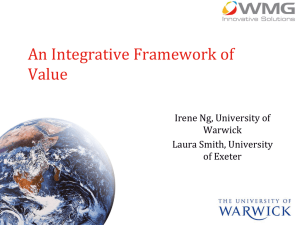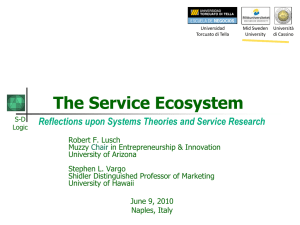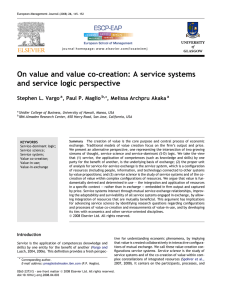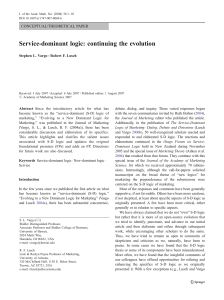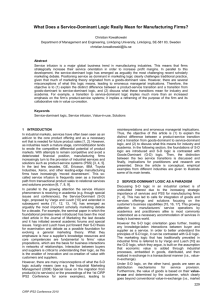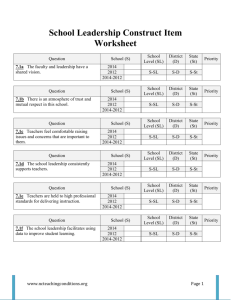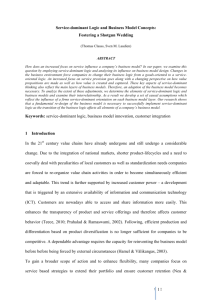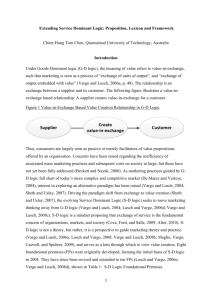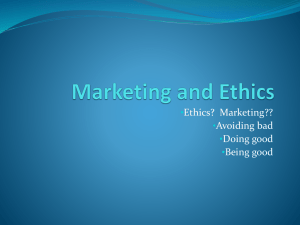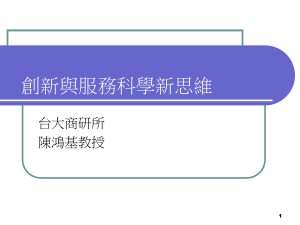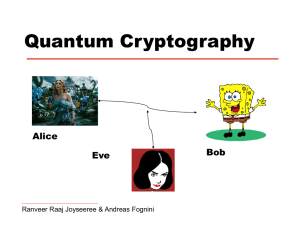- International Marketing Trends Conference
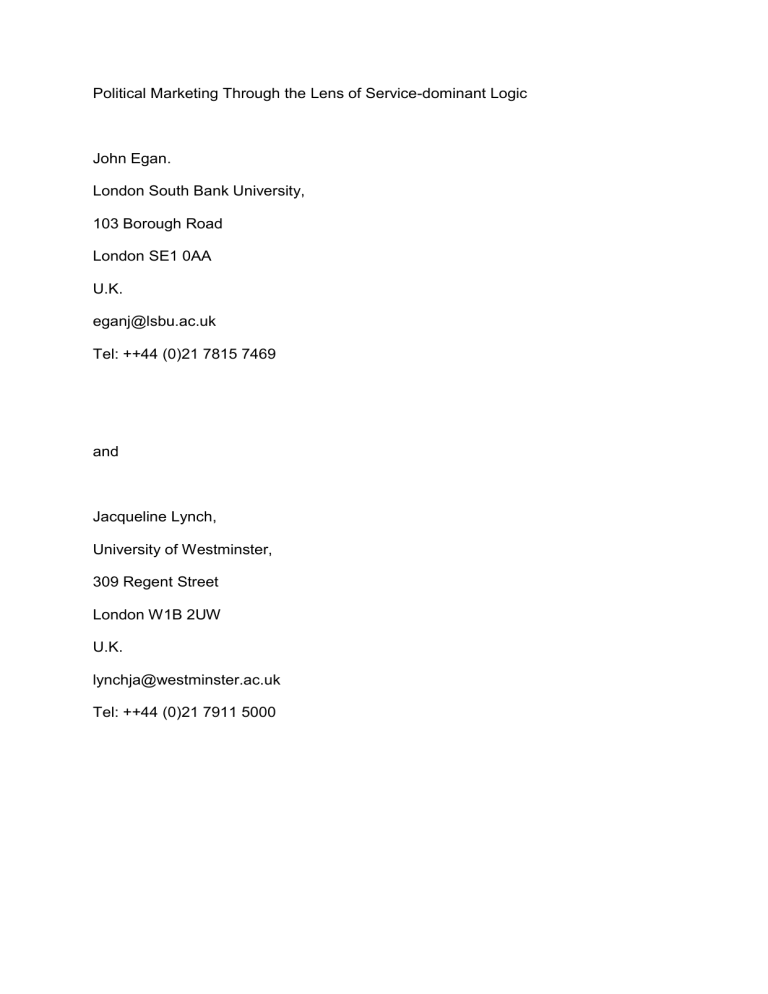
Political Marketing Through the Lens of Service-dominant Logic
John Egan.
London South Bank University,
103 Borough Road
London SE1 0AA
U.K. eganj@lsbu.ac.uk
Tel: ++44 (0)21 7815 7469 and
Jacqueline Lynch,
University of Westminster,
309 Regent Street
London W1B 2UW
U.K. lynchja@westminster.ac.uk
Tel: ++44 (0)21 7911 5000
Political Marketing Through the Lens of Service-dominant Logic
Abstract
Although political marketing has been practised for centuries it really came to academic prominence in the last decade of the twentieth century. It has not, however, been a smooth assimilation into mainstream marketing academia. The problem was that the traditional marketing framework did not fit neatly into how political marketing was configured. In 2001
Dean and Croft attempted to rectify these anomalies by applying the concepts and techniques of what some were calling marketing’s new paradigm – relationship marketing. They concluded (pg. 1211) RM offered a ‘plausible prescription for politics’
Marketing theorising rarely stands still. In 2004 Vargo and Lusch published a seminal article on the ideas and conceptions around Service-dominant (S-D) logic much of which has its roots in RM research and other concepts. This paper seeks to extend debate in the field of political marketing by viewing it through the lens of Service-dominant Logic and establish whether it too offers a ‘plausible prescription for politics’.
This conceptual paper concludes that viewing political marketing through the lens of S-D logic offers interesting insights particularly at the macro level. However, it is difficult to see how this can be operationalised. In addition, by promoting S-D logic as marketing’s new thinking (if not paradigm) that there is a danger of stifling rather than expanding knowledge.
Introduction.
The application of marketing principals to politics has an ancient pedigree albeit its academic study is considerably more recent and possibly more troubling. Despite a modern recognition of its centrality in the political process, from an academic perspective it is perceived as not quite fitting many of the principals and concepts that have grown up around the genre (Lock
& Harris 1996). These anomalies manifest themselves in a number of ways. The space politicians and their supporters occupy differs from ‘normal’ commercial operations. As
Brennan & Henneberg (2008, p.564) put it “a business exists to make money for shareholders by serving customers. A government exists to serve the interests of all citizens, including those who voted for the governing party, those who voted against, non-voters, and the disenfranchised”. The political organisation is, therefore, (in commercial terms) responsible for customers and non-customers alike. Further, traditional marketing is based on the notion of exchange and, with consumer goods, it was generally clear where and when this exchange took place. In politics it was difficult to see what exactly the exchange was and where and when this happened. If we presume, on the basis of the transactional theory, that the act of voting satisfies a need (e.g. party/candidate support) the ability to fulfil this promise is confined to certain dates often years apart. In addition to the periodic nature of politics there is the finality of the win-lose dimension (Butler & Harris 2009). Whereas in business a
‘follower’ (e.g. Avis) might be profitable in its secondary position in the market place, in politics (especially, but not exclusively in first-past-the-post elections) the winner(s) take all.
As a result there is no guarantee that an individual’s preference (party or candidate) will ultimately represent them at a local, national or trans-national level. Even tools associated with the traditional marketing paradigm whilst being utilised were adapted for different purposes. Segmentation and targeting, for example, were used but not to develop higher market share or a differentiated market space but to concentrate on the minority of voters
(frequently swing-voters in marginal constituencies) that make a disproportionate difference to the overall result. In every area except one, that of campaigning, traditional marketing did not fit neatly into a political marketing configuration (Harris & Lock 1996).
For perhaps the reasons noted above much political marketing research concentrated on campaigns and campaigning. Despite the recognised anomalies most political marketers were not, at the turn of the century, paying much attention to more recent theoretical developments that were being debated and the underlying multiplicity of prominent schools of thought in the discipline (Henneberg and O’Shaughnessy 2009) many of which challenged the traditional paradigm. Not that every trend would be important and/or applicable. As Brennan and Henneberg (2008 p.559) noted in relation to political marketing, rather than ignore new theories and concepts “they should perhaps be evaluated on the basis of presumed innocence
(usefulness) until proven guilty (irrelevant)”.
Relationship Marketing
One such concept attracting considerable attention at the beginning of the twenty-first century was Relationship Marketing (RM). Many authors were describing RM as the new marketing paradigm (e.g. Kotler 1992, Gummerson 2001) and Grönroos (1996) hailed it as representing the biggest change in marketing in 50 years. From a political perspective Dean and Croft
(2001, p.1198) suggested that a RM approach represented a philosophical alternative to what they described as the ‘straightjacket’ of ‘conventional’ transaction-based marketing and was more applicable to politics than the transactional model. They noted that RM viewed marketing management as a series of relationships and that this conception more closely met the requirements of political marketers. Significantly RM was seen as an outcome of service
(rather than product) marketing research. This suited the enlightened view that that politics was more about service than representation. According to Henneberg and O’Shaughnessy
(2009) the main thrust of relational strategies would be the greater involvement of voters who would be consulted more often and not always for election purposes. This, in their words, would create “a better informed political nation” (p.13). This fulfilled the growing aspiration of the public and the willingness of politicians (for example in the UK through freedom of information legislation) to encourage a more ‘open’ society.
Relationship marketing was seen as long-term. It aimed to extend political marketing’s influence beyond the immediate campaign, where before it had been narrowly conceptualised
(Butler & Harris 2009). It was conceived as extending to the full-time (in the sense of regular contact) relationship between the customer (voter) and those seeking their support. It inherently invited dialogue as it was based on a continuous on-going activities including policy development, communication, implementation and, importantly, long-term relationship management (Henneberg, Scammell and O’Shaughnessy (2009) Whereas, under the old model, exchange was characterised by ‘transactions’ carried out by active sellers and passive buyers, relationship marketing recognised networks of actors, where direct and indirect interactions were relevant and where customers were involved in the value-creation process in cooperative and collaborative ways (Henneberg and O’Shaughnessy (2009). Value considerations were conceptualised as based of an acknowledgement of the interdependency of the actors involved in the exchange and grounded in mutual benefits and societal needs that is “a voter-inclusive approach” (Henneberg, Scammell & O’Shaughnessy 2009 p.170).
As a central objective of political marketing may be seen to be the enabling of political parties and voters to make informed, need-orientated decisions (O’Cass 2009) the ‘fit’ between RM and politics would seem apparent. Dean and Croft (2001), in their review, concluded (p.1211) that relationship marketing “appears to offer a plausible prescription for politics”. Despite this by the end of the first decade of the new century there continued to be a
“remarkable neglect of relationship marketing in politics” (Henneberg and O’Shaughnessy
2009, p.5).
Service-dominant Logic
Marketing thought doesn’t stand still. In the decade since the Dean &Croft article other theories and concepts have been developing and are being widely discussed. Among the most talked about is Service-dominant (S-D) logic (Vargo and Lusch 2004). The ideas and conceptions around S-D logic appeared, to quite considerable fanfare, in a Journal of
Marketing article in 2004 and were followed up by articles and texts by these same authors and other collaborators) in the period since (e.g. Lusch and Vargo 2006, Vargo and Lusch
2006a, 2006b, 2006c, 2008, Vargo 2008). At the basis of S-D thinking is whether, with so much fragmentation in thinking, marketing theory was evolving towards a new, dominant, service logic having been dominated by a goods-dominant agenda for much of the proceeding century.
S-D logic was, from the beginning, more a development of ideas from earlier phases of research in areas such as relationship marketing, network perspectives and the resource-based approach rather than something wholly new (Aitken, Ballantyne, Osbourne & Williams
2006). Indeed it was said to be evolution rather than revolution that was being presented with the common feature that it was a response to the inadequacies of traditional goods-dominated marketing (Lusch & Webster 2011). Vargo & Lusch (2006a) saw RM in particular as a stepping stone between the goods-dominant logic and their own thinking. Thus whereas RM saw the development of services, S-D logic banished the distinction with goods which were characterised instead as distribution mechanisms for service provision. Whereas RM talked about co-production S-D logic talked about co-creation of value arguing that this value can only be determined by the user in the consumption process and through use (so-called ‘value-
in-use’) either directly or mediated by a good. In this context service was a perspective on value rather than a category of market offering (Edvardsson, Gustafsson, and Roos 2005).
Indeed Vargo & Lusch (2006a) conceptualised value as uniquely and phenomenologically determined by the beneficiary. The logical consequence of this view was to recognise that the enterprise did not deliver value in the exchange per se rather they made value propositions to the customer (Vargo 2008).
The S-D logic view also embraced much of the thinking known as the resource-based view
(RBV) or perspective which had become a prominent concept in general management.
Lynch, Baines & Egan 2006 had explored this previously from a political marketing dimension and concluded that there was a need to explore the role of key political party characteristics from a resource-based perspective. In a similar vein S-D logic proposed rebuilding marketing on the foundation of human knowledge and skills, information and interconnectivity (Butler & Harris 2009). This involved the identification and development of core competences and other entities (potential customers) that could benefit from these competences (Vargo and Lusch 2004). These ‘operant resources’ were seen as the fundamental source of competitive advantage. In S-D logic ‘service’ is a transcending concept defined in terms of using competencies for the benefit of another party (Lusch &
Webster 2011)
S-D Logic and Political Marketing
Having established that political marketing is a poor fit with traditional marketing, that RM may offer a plausible prescription and that RBV is a potential source of party political advantage, how does Political Marketing look through the lens of S-D logic?
As noted the concept of exchange sits uncomfortably in the political context. In a viewpoint where service is seen as the foundation of exchange this suggests a different purpose and
process for marketing and which provides service to all stakeholders (Vargo & Lusch 2006a).
In political terms this might seem to extend marketers’ influence to supporters, detractors and the community (whether or not voters) at large. Through the lens of S-D logic there was no difficulty in accepting the conception of an ‘exchange’ but a new model without the perceived inadequacy of the old one built on goods being exchanged for money (Vargo &
Lusch 2006a). Thus S-D logic may prove attractive to political marketing researchers if it speaks clearly to their interests and commitment to a distinct form of exchange (Butler &
Harris 2009). Goods-based marketing, which politics imitated, had locked itself into persuasive message-making as the dominant communications role. Service-based communication, however, implies dialogue and, by way of contrast, holds out the promise of staff/supporters developing relationships with actors and networks in the political marketplace (Ballantyne & Varey 2006). S-D logic points towards often intangible, dynamic resources (Lusch & Webster 2011) which may help explain the fickleness of some political decision-making. Capability refers to the organisational capacity to deploy resources, generally in combination with the organisation’s processes (O’Cass 2009) and may prove a model for political party organisation. If all social and economic actors are resource integrators (Vargo & Lusch 2006) then the interaction between them instigates value creation. A political party’s structure and processes must enable them to act as integrators of resources through which they can obtain competitive advantage (O’Cass 2009).
There was also a conceptual challenge in the traditional marketing paradigm concerning the idea of value and what it represents in the political sphere (Brenan & Henneberg 2008).
When the organisation possesses capabilities that can be proactively converted into value for voters they might be said to have a competitive advantage (O’Cass 2009). S-D logic suggests that marketing’s role is to create value at all stages in the relationship. (Vargo2008) but not all relationships are going to be the same. In some instances the value created is perceived to
be in relation to the fulfilment of a social responsibility. We can vote therefore we should vote and the value comes from fulfilling this civic duty. In other instances self-interest plays a role, for example lower taxation or higher public spending. Satisfaction may come from the knowledge that the candidate/party may stimulate change that is beneficial to that voter/supporter. Tradition (or habit) undoubtedly plays a part. In this situation value may be seen to be created because the customer (voter) has received some satisfaction from a process which returns his or her previously favoured candidate/party. For longer-term supporters more continual contact and even comradery may be a source of satisfaction. Relationships are also not limited to dyads but nested within networks of relationships (Kowalkowski 2011).
Block-voting by certain communities, which is known to exist, is recognised in this model.
Backstage support from party workers provide service to internal customers (other workers/supporters) whilst others (e.g. canvassers) specialise in front-line activities
(Schembri 2006). This suggests that support for a party/candidate at a specific point in time
(e.g. an election) may not be the only point at which value is created; indeed the time-logic of marketing becomes open-ended (Ballantyne & Varley 2006).
Conclusion
Undoubtedly S-D logic has been well received by many in the marketing world. It has been described as ‘brilliantly insightful’ (Rust 2004:23), ‘finely crafted… and logically sound’
(Hunt 2004:22). At first glance there appears to be a clearer fit than the traditional model of marketing with politics in previously anomalous areas such as exchange, value and satisfaction albeit the finality of the win-lose situation still presents problems (even in longterm relationships). In particular the focus is on intangible resources, on the co-creation of value by stakeholders and on voters as active participants in relational exchange (Baron &
Harris 2006).
On the downside empirical support for S-D logic is sadly lacking and it’s been described as
‘closer to smoke and mirrors’ (Brown & Patterson 2009, p.530) insinuating more hot air than substance. Indeed it is the lack of practical application that is its decided weakness. Whereas at a macro level service delivery, exchange and co-creation can be conceptualised it is unclear how is this translated at an operational level. For example, those who devise the value propositions (which may lead to value creation) will need to think very carefully about the subjective value perceptions of all the various stakeholders if they are not to be accused of presenting mixed messages (Kowalkowski 2011). The concept of co-creating value has another theoretical flaw. If we take customer satisfaction as an indication of value creation
(Anderson, Pearo & Widener 2008), if the result does not go the way of the voter (either or both candidate or party) does this destroy value? Equally if you express an opinion but care little about the result or do not vote at all is any value actually created? There are dangers too in promoting full-time relationships with diverse audiences. Potentially this could result in decision-making by (frequently self-selecting) focus groups and the dangers of ‘knee-jerk’ reactive policies that this may encourage.
There is also a concern that S-D logic is promoted as replacing everything that went before it.
The word ‘dominant’ itself suggests it is believed to be the likeliest explanation of current marketing thinking a claim described by Brown (2007) as disturbing. O’Shaughnessy &
O’Shaughnessy (2009) also believe that promotion of a single prospective (however evolutionary) is regressive. Whereas Lusch & Webster 2011, p.17/8) complained that “old truths linger for too long in a world where we constantly are told that everything moves faster and faster” are we not in more danger of throwing the baby out with the bathwater?
Marketing is far too complex a notion to suggest only one viewpoint is acceptable (and operable) at any one time. In the Relationship Marketing (RM) literature, for example, there is explicit acceptance of transactional marketing, operating alongside. RM as a concept did
not replace Transactional Marketing it challenged it. By promoting S-D logic as marketing’s new thinking (if not paradigm) that there is a danger of stifling rather than expanding knowledge.
As the original authors themselves admit S-D logic is not yet fully formed and is “very much a dialogical and collaborative work in progress, one that is both evolving and developing”
(Vargo 2008:211). S-D logic has its weaknesses but may, now and in the future, offer insights that will advance our knowledge in the field of political marketing. Perhaps, however, it should be used sparingly.
References
Aitken, R., Ballantyne, D., Osbourne, P. and Williams (2006) ‘Introduction to the Special
Issue on the Service-dominant Logic of Marketing: Insights from the Otago Forum’
Marketing Theory 6(3) 275-80
Anderson, S. Pearo, L.K. and Widener, S.K. (2008) ‘Drivers of Service Satisfaction: Linking
Customer Satisfaction to the Service Concept and Customer Characteristics’ Journal of
Service Research 10(4) 365-81
Ballantyne, D. and Varey, R.J. (2006) ‘Creating Value-in-use Through marketing Interaction:
The Exchange Logic of Relating, Communicating and Knowing’ Marketing Theory 6(3) 335-
48
Baron, S. and Harris, K. (2006) ‘A New Dominant Logic in Marketing: Pedagogical Logic
Implications’ The Marketing Review Vol. 6 pp.289-300
Brenan, R. and Henneberg, S.C. (2008) ‘Does Political Marketing Need the Concept of
Customer Value?’ Marketing Intelligence and Planning 26(6) 559-72
Brown, S. (2007) ‘Are We Nearly There Yet? On Retro-dominant Logic of Marketing’
Marketing Theory 7 (3) pp 291-300
Brown, S. and Patterson, A. (2009) ‘Harry Potter and the Service-dominant Logic of
Marketing: A Cautionary Tale’
Journal of Marketing Management 25(5/6) 519-33
Butler, P. and Harris, P. (2009) ‘Considerations on the Evolution of Political Marketing
Theory’ Marketing Theory 9(2) 149-64
Dean, D. and Croft, R. (2001) Friends and relations: Long-term approaches to political campaigning. European Journal of Marketing Vol.35 No. 11/12 pp 1197-1216
Edvardsson, B., Gustafsson, A. and Roos, I. (2005), ‘Service Portraits in Service Research: a
Critical Review International Journal of Service Industry Management 16(1) 107-21.
Grönroos, C. (1996) ‘Relationship Marketing: Strategic and Tactical Implications’
Management Decisions 34(3) 5-14
Gummesson, E. (2001) ‘Are Current Research Approaches in Marketing Leading Us
Astray?’
Marketing Theory 1(1) 27-48
Henneberg, S.C. and O’Shaughnessy, N.J. (2009) ‘Political Relationship Marketing: Some
Macro/Micro Thoughts’
Journal of Marketing Management 25(1/2) 5-29
Henneberg, S.C., Scammell, M. and O’Shaughnessy, N.J. (2009) ‘Political Marketing
Management and Theories of Democracy’
Marketing Theory 9(2) 165-88
Hunt, S.D. (2004) ‘On the Service-Centred Dominant Logic for Marketing’ in Bolton, R.N.
(ed) ‘Invited Commentaries on Evolving to a New Dominant Logic for Marketing’
Journal of
Marketing 68 21-2
Kotler, P. (1992) ‘Marketing’s New Paradigm: What’s Really Happening Out There?’
Planning Review , 20, No.5 pp.50-52
Kowalkowski, C. (2011) ‘Dynamics of Value Propositions: Insights from Service-dominant
Logic’ European Journal of Marketing 45(1/2) 277-94
Lock, A and Harris, P. (1996) 'Political Marketing - Vive La Difference!’ European Journal of Marketing 30(10/11) 14-24
Lusch, R.F. and F. E. Webster Jr. (2011) ‘A Stakeholder-Unifying, Cocreation Philosophy of
Marketing’ Journal of Macromarketing 31 (2), 129-134
Lusch, R.F. and Vargo, S.L. (2006) ‘Service-dominant Logic: Reactions, Reflections and
Refinements’ Marketing Theory 6(3) 281-88
Lusch, R.F. and Vargo, S.L. (2006) ‘Service-dominant Logic: Reactions, Reflections and
Refinements’ Marketing Theory 6(3) 281-88
Lynch, R., Baines, P. and Egan, J. (2006) ‘Long-term Planning for Political Parties in the
United Kingdom: Towards a Competitive Resource-based Perspective Journal of Political
Marketing 5(3) 71-92
O’Cass, A. (2009) ‘A Resource-based View of the Political Party and Value Creation for the
Voter-citizen: An Integrated Framework for Political Marketing’ Marketing Theory 9(2) 189-
208
O’Shaughnessy, J. and O’Shaughnessy, N.J. (2009) ‘The Service-dominant Perspective: A
Backward Step?’ European Journal of Marketing 43 (5/6) 784-93
O’Shaughnessy, J. and O’Shaughnessy, N.J. (2009) ‘The Service-dominant Perspective: A
Backward step?’
European Journal of Marketing 43(5/6) 784-93
Rust, R.T. (2004) ‘If Everything is Service, Why is This Happening Now and What
Difference Does it Make’ in Bolton, R.N. (ed) ‘Invited Commentaries on Evolving to a New
Dominant Logic for Marketing’
Journal of Marketing Vol.68 pp.23-4
Schembri, S. (2006) ‘Rationalizing Service Logic, or Understanding Services as Experience’
Marketing Theory 6(3) 381-92
Vargo, S. and Lusch, R. (2004) ‘Evolving to a New Dominant Logic for Marketing’
Journal of Marketing Vol.67 No.1 pp.1-17
Vargo, S.L and Lusch, R.F. (2006a) Service-dominant Logic: What is it, What it is not, What it Might be. in R.F. Lusch and S.L. Vargo (eds) The Service-dominant Logic of Marketing:
Dialogue, Debate, and Directions Armonk, N.Y., M.E. Sharpe pp 43-56
Vargo, S.L and Lusch, R.F. (2006b) ‘Service-dominant Logic: Continuing the Evolution’
Journal of Marketing Science 36(1) 1-10
Vargo, S.L and Lusch, R.F. (2006c) ‘Service-dominant Logic: Reactions, Reflections and
Refinements’ Marketing Theory 6(3) 1-8
Vargo, S.L and Lusch, R.F. (2008) ‘From Goods to Service(s): Divergences and
Convergences of Logics’ Industrial Marketing Management 37(3) 254-9
Vargo, S.L. (2008) ‘Customer Integration and Value Creation: Paradigmatic Traps and
Perspectives’ Journal of Service Research 11(2) 211-15
